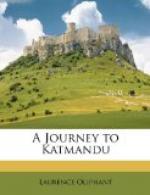We now heard a terrific bellowing at a short distance, which, in my ignorance, I thought proceeded from a huge tusker making a gallant resistance somewhere; I was rather disappointed, therefore, to find that the object of interest to a large group of men and elephants was only a young one struggling on his back in a deep hole into which he had fallen, and from which he was totally unable to extricate himself. Lying on his back, and kicking his legs wildly about in the air, he looked the most ridiculous object imaginable, and certainly made more noise in proportion to his size than any baby I ever heard. So incessant was his roaring that we could scarcely hear each other speak; at last, by means of ropes attached to various parts of his body, and by dint of a great deal of pulling and hauling, we extricated the unfortunate infant from his awkward position.
The poor little animal had not had a long life before experiencing its ups and downs, and it now looked excessively bewildered at not finding its mother, who had escaped with the rest of the herd. He was soon consoled, however, by being allotted to a tame matron, who did not seem particularly pleased at being thus installed in the office of foster mother whether she liked it or not.
We now all jogged home in great spirits, and, though Jung professed himself dissatisfied with only having captured four out of a herd of twelve, we were perfectly contented with a day’s work which my elephant-shooting experience in Ceylon had never seen equalled, and which so fully realised the promise made by the minister at starting, that we should be the first to partake of a sport to be met with only in the noble forests of his native country.
CHAPTER VI.
March to Bhimphede—National defences—The Cheesapany pass—Lovely scenery—Night adventure—The watch-fire—Reception at camp—Arrival at Katmandu.
We had looked forward with no little anxiety to the morning following our elephant-hunt, as we were to go in search of rhinoceros: it was therefore a severe disappointment to us when Jung entered our tent at daylight, and informed us that it was necessary we should at once proceed on our way to Katmandu. The reason he gave us was, that we should have to go too far out of our route before we could find our game: however that might be, there was no help for it, and we commenced our march up the valley of the Rapti, along the narrow rocky path leading to Bhimphede, our next halting-place. It was a five hours’ march, and we crossed the river thirty-two times before we came in sight of the picturesque Durumsolah, or native rest-house, which is situated at the head of the valley. Hills clothed to their summits with variegated jungle rose above us to an immense but not uniform height, and the scenery looked bolder as we became more enclosed among the mountains.
Bhimphede is a Newar village, the inhabitants being the aborigines of the country. It is said to derive its name from a Hindoo divinity named Bheem having on some occasion happened to stop there. It is distant from Hetowra about 18 miles, and the road might be much improved by a little engineering.




